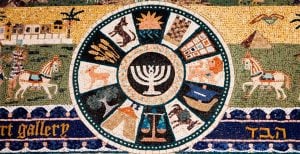
The recently excavated 1,700-year-old oil lamp from Jerusalem, showing a Temple menorah design (Photo credit: Emil Aladjem/Israel Antiquities Authority)
The ancient lamp is decorated with a depiction of a seven-branched menorah, as a reference to the menorah that once stood in the Holy Temple.
This menorah design is a special symbol of Judaism's holiest place, and has historically been also used as a representation of Judaism itself and the Jewish people - a religious and cultural symbol that's even older than the Star of David!

Scholars from the Israel Antiquities Authority showing the ancient lamp (Photo credit: Emil Aladjem/Israel Antiquities Authority)
The discovered lamp was made a few centuries after the destruction of the Second Temple by the Roman army, which had looted the Temple Menorah as well. This means that despite the Temple and its menorah no longer standing, the Jewish people of Jerusalem and Judea still held them close to their hearts enough to depict them on their everyday objects!
Other symbols depicted on the lamp along with the menorah are an incense shovel, like the one used by the Priests in Temple rituals, and a lulav, which is a date palm branch used in Jewish rituals such as during the holiday of Sukkot.
According to the Israel Antiquities Authority, this oil lamp "is a fascinating testimony connecting everyday objects and faiths among ancient Jerusalem’s inhabitants. It seems that the lamp belonged to a Jew, who purchased it because of its religious affiliation and memorial to the Temple."
This amazing and inspiring artifact, in the words of Israeli Minister of Heritage Rabbi Amichai Eliyahu, "expresses the deep and long-standing connection of the nation of Israel to its heritage and to the Temple’s memory."
Ready to bring a reminder of Jerusalem and the Holy Temple into your own home?
Shop our Temple-inspired gifts and other amazing Jerusalem gifts by Israeli artists right in our online shop here!




















